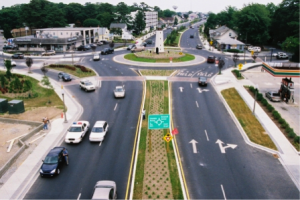What Is Streetscaping?

Streetscape is a term “that refers to is used to describe the natural and built fabric of the street, and defined as the design quality of the street and its visual effect.” The concept recognizes that a street is a public place where people are ableto engage in various activities. Streetscapes and their visual experience largely influences public places where people interact, and it ultimately helps define a community’s aesthetic quality, economic activity, health, and sustainability.
A successful streetscape has multiple aspects. Because all roads have multiple users and serve many functions, each streetscape design must be context-sensitive. Transportation systems must consider the context or physical setting and use design approaches and materials that are consistent with local conditions. A streetscape needs to have boundaries to ensure safe travel for all roadway users. Signs, curbs, fences and landscaping can effectively create an inclusive, yet safe environment that provides a sense of physical comfort for diverse users and activities. The aesthetic appeal elements of beautification initiatives, attractive lighting, street furniture, clean streets, and outdoor dining contribute to a town’s sense of place. Amenities should be designed to get people out of their cars to socialize, interact with their environment, and discover other mobility options.
How Is Streetscape Compatible with Complete Communities Principles?
Streetscaping is compatible with several elements of planning for Complete Communities in Delaware, including Complete Streets and efficient land use. The Urban Street Design Guide by the National Association of City Transportation Officials (NACTO) reinforces the need to design spaces where people can safely walk, bicycle, drive, take transit, and mingle. Well-designed and maintained streetscapes create comfortable, beautiful streets that fit in with Complete Streets principles. All elements and principles aim to create a destination that will entice drivers to park, walk into town and enjoy the community. In addition to accommodating a range of transportation options, streetscaping supports revitalization initiatives, sustainability, and a mix of efficient land uses that includes retail, living space, recreation, and office space.
Benefits of Streetscaping
If properly executed, streetscaping can positively affect a community in multiple ways. Streetscaping incorporates principles of Complete Streets. Delaware’s Complete Streets policy strives to design, build, and maintain transportation systems to safely accommodate travelers of all ages and abilities—motorists, pedestrians, bicyclists, and public transit users.
Improvements to crosswalks, traffic control devices, treatments to assist persons with disabilities, bus-stop placement, safe routes to school, and traffic-calming can enhance safety and provide effective countermeasures to accidents. Streetscapes that provide greater mobility and access to transportation choice can also lead to more healthy and active lifestyles.
Attractive and inviting streetscapes that provide a safe built environment for pedestrians can help spur local economic activity. According to a report, Walking the Walk, walkability can help revitalize a downtown, increase private investment, and support the development of a good business climate. Pedestrian, bicycle, and transit-friendly streetscapes can be achieved by widening sidewalks, providing buffers along the street, and reducing the frequency for curb cuts.
Streetscapes can help increase the environmental sustainability by decreasing automobile dependency, minimizing traffic and congestion, and reducing carbon emissions.
Landscaping beautification encourages the enrichment of biodiversity in a community. Streetscapes also integrate and preserve bodies of water such as rivers, lakes and pond as well as other natural features in order to create biodiversity and a thriving ecosystem. The Mispillion River Greenway links both sides of the river and allows access to Milford’s central business district, historic properties, and residential areas.
What Are the Best Practice Examples of Streetscaping Being Applied in Delaware?
Rehoboth Avenue, in Rehoboth Beach, Delaware is an excellent “best practice” example of streetscaping. The popular summer destination desperately needed a solution to safely manage seasonal traffic congestion from cars, walkers, and bikers. The City of Rehoboth set out to create an attractive business district and family-oriented public spaces to promote shopping, dining, strolling, biking, and entertainment.
Rehoboth officials, an Aesthetics Committee, residents, and the business community worked with the DelDOT and federal transportation officials to acquire funding and finalize the details of the Rehoboth Avenue streetscape project. The project was divided into three phases to minimize inconvenience to residents, tourists, and merchants. During the first phase, all above-ground utilities were removed and placed underground. Sidewalks were widened and marked with specially designated crosswalks. Parking areas were reconfigured to outer areas of the city and new on-street metered parking systems were installed. New lighting and landscaping was installed as part of a street beautification project that aimed to further entice pedestrian activity and aesthetically soften the parking areas.

Source: http://www.cormanconstruction.com/project-portfolio/streetscape/rehoboth-beach-streetscape-%E2%80%93-phase-ii/
The second phase of the project created a boundary and gateway to Rehoboth Avenue. A traffic-calming roundabout was placed at the beginning of Rehoboth Avenue in order to slow traffic. A replica of the Cape Henlopen lighthouse was placed on top of the roundabout in order to create a gateway. The final phase created a public pavilion at the end of Rehoboth Avenue that echoed the same appealing style of the gateway.
How to Plan for A Streetscape Project in Your Community
DelDOT is responsible for planning, designing, building, and managing the majority of Delaware’s statewide transportation systems and roadways. Any transportation projects that are intended to use federal funds, along with all non-federally projects that are regionally significant, must be vetted through a Transportation Improvement Program (TIP) process that is oversee by a Metropolitan Planning Organization (MPO). The TIP is the regionally agreed upon list of priority multi-modal transportation projects, including streetscaping projects. TIP projects that are approved for funding will seek stakeholder input through a public participation process. DelDOT will work with local officials and stakeholders to ensure that streetscapes conform to DelDOT design guidelines and policies, provide context-sensitive solutions, and include Complete Streets principles.





